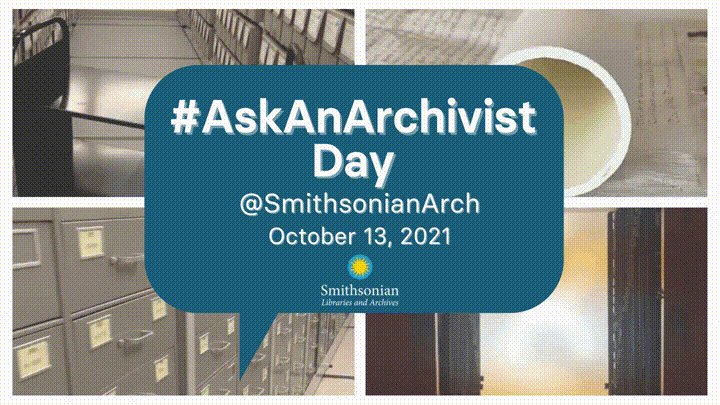As the Smithsonian Institution Archives social media manager, #AskAnArchivist Day is always something I look forward to. It’s a day when I get to learn from my colleagues, interact with our followers, and just get to have a lot of fun playing around. Below are just a few of the questions we answered this year.

Can you talk about some strategies for doing online research during These Difficult Times?
Deborah: I wrote a blog post about online research strategies. How do you get the biggest (Smithsonian knowledge) bang for your (archival research) buck? Start with the Biodiversity Heritage Library and the Smithsonian Transcription Center.
Are there any specific media formats in your collections that you find super frustrating to preserve and make accessible to researchers?
Alison: We've got quite a few. Magnetic media (open reel audio tape & many video formats) deteriorates at a rapid rate. It's difficult to preserve due to its "degradescence"— it degrades quickly and the playback equipment used to preserve the content is often obsolete. Iron gall ink is challenging to preserve because, as it ages, the excess iron sulfate in the ink causes degradation of the paper or parchment support underneath. Over time, you can actually lose large pieces of the support because it becomes so brittle, thus losing content. Oversize photographs and maps can be a challenge to preserve but are even more challenging to serve safely to researchers. Excessive and inappropriate handling of large objects can often cause more damage than any inherent issues with the material itself!
What projects are your staff working on right now?
Mitch: I recently accessioned the email account of Dr. Spencer Crew, interim director of the National Museum of African American History and Culture (NMAAHC) and former director of the National Museum of American History. This new accession only covers his time at NMAAHC.
How do you know what’s worth preserving/archiving and what is just clutter?
Deborah: Collection development policies! Every archives has (or should have) one. When you assess new materials, you decide whether they meet your archives/ collecting scope. Retention schedules also help a lot for institution archives like ours.
What does a typical day look for a conservator at an archives?
*knocks on the conservation lab door*

I found William Bennett treating a drawing of bee genitalia from the paper of entomologist Grace Sandhouse (Record Unit 7456).
What was your favorite find from your holdings in 2021?
Deborah: Last week, I came across a brouhaha between Smithsonian Tropical Research Center scientists and Hollywood producers in 1953 over...ants. Though the crew of the The Naked Jungle (1954) initially planned to film army ants in Panama, they settled for carpenter ants in the studio. Ever the "'sticklers' for the truth," the Smithsonian scientists insisted the film producers avoid misidentifying the ants. They promised: "we shall in no way attempt to present them as army ants from Barro Colorado Island."
![Letter to Assistant Secretary Dr. John E. Graf from James Zetek, September 24, 1953, Smithsonian Institution Archives, Record Unit 135. Letter noting that the producers will in "no way attempt to present them [the ants] as army ants fro](https://siarchives.si.edu/sites/default/files/blog-attached-images/FBm4KTqUcAIQOp2.jpeg)
What's the raddest piece of music that's come in with a collection, inadvertently or otherwise?
Emily: The “Smithsonian Polka” slaps.
Related Resources
- “#AskAnArchivist 2020: Sharing from Home” by Emily Niekrasz, The Bigger Picture, Smithsonian Institution Archives
- “#AskAnArchivist 2019: The Year of the GIF” by Emily Niekrasz, The Bigger Picture, Smithsonian Institution Archives
- “#AskAnArhivist 2017: You Asked, We Answered” by Effie Kapsalis, The Bigger Picture, Smithsonian Institution Archives
Produced by the Smithsonian Institution Archives. For copyright questions, please see the Terms of Use.

Leave a Comment